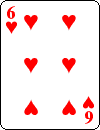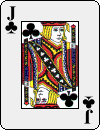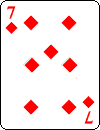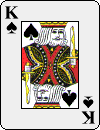- About MAA
- Membership
- MAA Publications
- Periodicals
- Blogs
- MAA Book Series
- MAA Press (an imprint of the AMS)
- MAA Notes
- MAA Reviews
- Mathematical Communication
- Information for Libraries
- Author Resources
- Advertise with MAA
- Meetings
- Competitions
- Programs
- Communities
- MAA Sections
- SIGMAA
- MAA Connect
- Students
- MAA Awards
- Awards Booklets
- Writing Awards
- Teaching Awards
- Service Awards
- Research Awards
- Lecture Awards
- Putnam Competition Individual and Team Winners
- D. E. Shaw Group AMC 8 Awards & Certificates
- Maryam Mirzakhani AMC 10 A Awards & Certificates
- Two Sigma AMC 10 B Awards & Certificates
- Jane Street AMC 12 A Awards & Certificates
- Akamai AMC 12 B Awards & Certificates
- High School Teachers
- News
You are here
The Bligreath Principle
August 2009
In August 2005 and August 2006 we explored the Gilbreath Principle(s). On this August occasion, we investigate a related principle published on a web magic forum in 2005, with the kind permission of its electrical engineering trained author, legendary "binary magic" creator Leo Boudreau. It should soon be clear why we are dubbing it the Bligreath principle.
As remarked in the August 2006 Card Colm, while riffle shuffling is generally assumed to randomize a deck of cards, a single riffle shuffle of a suitably prearranged deck can lead to some quite predictable results. In the case of Gilbreath shuffles, one first deals ("approximately half of the") cards off the deck into a pile, thereby reversing their order, before riffle shuffling the resulting two piles together. For a Bligreath shuffle, on the other hand, one merely splits the deck "close to the middle"—subject to a matching condition to be discussed in due course—and then riffles the two piles together. In practical terms, this makes Bligreath shuffling quicker and easier to do than Gilbreath shuffling, and the relationship between the names reflects the fact that the top "halves" of the deck in the two shuffles are in opposite order.
Just as in Gilbreath shuffling, the kind of prearrangement we have in mind is some kind of cyclic repetition, for instance, a whole deck consisting of thirteen stacked repeats of four cards in a fixed suit order, e.g., CHaSeD: ♣, ♥, ♠, ♦ (while ignoring values). There is no need to use an entire deck; indeed, using fewer cards often gives rise to packet sizes with more interesting factorizations than 52.
In general, we consider packets of mn cards which consist of m stacked repeats of a particular set of n cards, each set being in the same fixed order with respect to some key characteristic. E.g., we can have n = 4 as suggested above, in a particular suit order each time, or perhaps n = 13 with all possible values in some fixed special order, or maybe n = 6 with the cards in each set consisting of Ace, 2, 3, 5, 8, King (in that order).
Bligreath shuffling such a packet means separating it between any
two of the sets of n cards—so that the bottom cards of each
resulting pile match—and then simply riffle shuffling those two piles together.
(As noted on yet another August occasion, riffle shuffling a packet can also be achieved by employing Lennart Green's rosette shuffle:





Start with the piles side by side, as shown in the first image, then use the fingers to "twirl" the left pile into a rosette; the second image shows the result. Repeat for the right pile, and then push the rosettes together. Square up the packet: it has effectively been riffle shuffled.)
What Norman Gilbreath noticed 50 years ago was that when one reverses, before riffle shuffling, "half" of the cards in the kind of prearranged packet we have in mind—e.g., by dealing into a pile—then the resulting packet has a very special property: from the top down (or the bottom up) counting n cards at a time, we are sure to get sets in which there is one card of each type. E.g., if n = 4 as above, in each group of four cards, starting from either end of the packet, there will be one of each suit, although just in what order they turn up is anybody's guess.
The question we need to ask is this: what (if any) order or structure remains after a Bligreath shuffle?
The answer is, plenty! As in the case of Gilbreath shuffling, it helps to focus on the cards in clumps of n (from either end of the shuffled packet).
Here is an easy special case: a packet consisting of alternating odd and even values (representing 1 and 2 mod 2), with the clubs and spades on top, e.g., this sixteen card packet: A♣, 2♠, 3♣, 4♠, 5♣, 6♠, 7♣, 8♠, A♥, 2♦, 3♥, 4♦, 5♥, 6♦, 7♥, 8♦ (the suit alternation here permits additional post-shuffle tracking which we leave to the interested reader). Split between the black and red cards and riffle or rosette shuffle. While theoretically there are (16!)/(8!8!) = 12870 different results overall (many of which are unlikely under a rosette shuffle!), there are only two possibilities for the parity distributions of the top two cards: odd, even (A♣, 2♠ or A♥, 2♦), or odd, odd (A♣, A♥ or A♥, A♣). Trivially, knowledge of the second card determines the parity of both of the top two cards.
What happens if we are working with 4m cards in CHaSeD (♣, ♥, ♠, ♦) order? One thing is for sure: the suit of the fourth card, after the shuffle, gives information about the overall suit composition of the first three cards. For instance, if the fourth card is a Spade, then regardless of which of the two riffled piles it came from, the Club and Heart from that pile must also be among the first three cards, whereas the Diamond is not. This leaves one card among the first three unaccounted for; it must be the initial Club from the other pile. So the first three cards are in fact two Clubs and a Heart.
We can also work at the other end of the shuffled packet. Consider the final four cards: the suit of the fourth to last card reveals the suit distribution of the last three (or four) cards. Furthermore, if the original packet were such that one pile consisted of odd valued cards, and the other even values—in addition to having cycling suits—then more conclusions could be drawn, depending on the parity of the fourth card from either end.
The above all works in the general case. These observations can be put to use in various ways as prediction tricks, perhaps in conjunction with our later analysis of the whole shuffled packet (including each "interior" clump of n cards).
It Needs Help
Suppose we have a packet of mn cards made up from m stacked repeats of a particular sequence of n cards. Split the packet in two so that both piles have "matching" bottom cards (i.e., are the last in the sequence). Riffle shuffle the piles together. Now deal n cards into a pile face-down and set the rest of the packet aside. Turn over the top card of the dealt pile. Knowledge of this card reveals the composition of the rest of that pile, though not the precise order in which those cards appear.
Let's look at the case where m = 4 and n = 6, where each sequence consists of an Ace, 2, 3, 5, 8, King in that order, with random suits. Split the packet of 24 cards in the middle and have the two halves riffled together. Deal out six cards into a face-down pile, and turn over the top card; suppose it's a 2. Then there must also be the Ace which preceded it, from whichever half it came, together with the Ace, 2, 3 and 5 from the other half.
Suppose one wishes to use the above to impress a spectator, who has just done a riffle or rosette shuffle at your instigation. In the case of cycling suits, there is so little room for repetition that no adjustments need to be made, but in the case of cycling values, such as Ace, 2, 3, 5, 8, King, the reality is that if the spectator inspects the rest of pile under the exposed card, as is, then too much is revealed: something like Ace, Ace, 2, 2, 3, 4, 3, 5, 4, 5, ... will be seen, which will likely arouse suspicion that the original packet was set up. So before you feel tempted to say, "I can predict what cards are in the rest of the pile, despite the shuffle you just did," feel free to have incriminating evidence distroyed by encouraging additional jumbling of the cards under the exposed one, or simply pick them up and mix them in hand yourself!
(Upon reflection, it should be clear that using the same cycling values in both "halves" of the deck is not at all necessary; one can use any known values one likes and still track some information after a single riffle shuffle. This fact has been used by some magicians for over a century.)
Rather than predict information about what card values are in the dealt pile, based on the value of one visible card, you can opt to do something with the deduced values, e.g., you can predict the sum (or product) of the values (with or without the top card, that's your choice).
We need to move on to consider more than just a single dealt pile.
Posh Title Here
Again, suppose we have Bligreath shuffled a packet of mn cards made up from m stacked repeats of a particular sequence of n cards. In addition to dealing out a pile of n cards face down, as before, also deal a second such pile, then a third, and so on, continuing until m piles have been dealt. Note that each pile is completed before moving on to the next one. Finally, turn over the top card of each dealt pile.
Knowledge of these exposed cards reveals the composition of each pile, not just the "boundary clumps" (the first or last sets of n cards). For the internal clumps, one must "work in from the edge." The fact is that each clump yields information about its two immediate neighbouring clumps. In what follows, we work from left to right, but with appropriate adjustments, one can work in the other direction. (In the latter case, instead of turning over the top card of each pile dealt, simply turn over each pile as a unit, to reveal only its bottom card.)
Let's look at a specific example. Suppose you start with a full deck of four stacked repeats of all thirteen values in standard order from Ace to King. We assume random suits, though if you keep them separate so that you then shuffle reds into blacks, it's easier to analyze "the threads of the argument." While it's also possible to perform a few fair-looking cuts of the whole packet before splitting and riffle shuffling, making appropriate analytical adjustments later, bearing in mind which value was at the bottom of each half after the split, for simplicity we assume that when the packet is split in the middle, there are Kings on the bottom of each half.
After a spectator riffle shuffles, deal the cards face-down into four piles of thirteen, completing each pile before moving on to the next. Turn over all four top cards. Suppose you see the following.








As Leo Boudreau observes, to determine the composition of any particular pile, say one with value Y on top, you need simply note the value X of the top card of the pile to its immediate left (this also works for the first pile, wrapping back around to the last one). Then use this recipe:
Working mod 13 (so that values above 13 are reduced by 13, but 13 itself is left as
it is) the pile of interest (with Y) on top certainly contains the Y - X values between
X + 1 and Y. Usually, this leaves some cards unaccounted for, 13 - (Y - X) of them,
to be precise. In such cases, the pile also contains that many cards starting with
value 14 - X and counting until we get to [14 - X] + [13 - (Y - X)] - 1 = 13 - Y.
(We leave it as an exercise for the curious reader to justify this claim. Needless to say, it generalizes to repeated stacks of any size.)
For instance, the second pile above has a Jack on top and the first pile has a 6, so X = 6 and Y = 11. Hence the second pile contains five cards with values 7, 8, 9, 10, 11 for sure. It also contains eight cards with values 8, 9, 10, 11, 12, 13, 1, 2.
Now see if you can determine the composition of the remaining piles using the recipe given above.
As hinted earlier, one can easily get away from the "suspicious doubling up of midrange values" by stacking the cards in some customized (and memorized), but apparently random, order. Then the observations above all hold for the index values of the cycled cards, rather than the card values themselves.
Thanks to Joe Mckay for the timely alert which made this column possible.
"Bligreath" (like "Gilbreath") is an anagram of "garble hit"—so is "be alright." "It needs help" is an anagram of "the end piles," and "posh title here" is an anagram of "the other piles."




